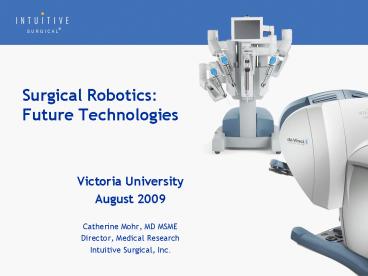Surgical Robotics: Future Technologies - PowerPoint PPT Presentation
1 / 28
Title: Surgical Robotics: Future Technologies
1
Surgical Robotics Future Technologies
- Victoria University
- August 2009
- Catherine Mohr, MD MSME
- Director, Medical Research
- Intuitive Surgical, Inc.
2
- Innovation
The first transistor out of Bell Labs Dec 16,
1947
3
- Innovation
The first headlamp used in surgery with Cushing
at Harvard (1930)
4
- Innovation
The first da Vinci setup joint (1996)
Will this be the beginning? the end? just a
step along the way? How do you know?
5
- Industrial Telepresence
Nuclear Telemanipulation Master-slave
6
- Military Telepresence
Various mechanisms developed to both track
movement and reflect forces (FREFLEX 1994)
7
- Early Surgical Robotics
Started with fixturing and cutting
PROBOT TURP 1984
Minerva neurosurgery 1985
RoboDoc hip replacement 1995
8
- Growth of Surgical Robotics
- Numerous variations over the years both
commercial and academic - Computer Motion laparoscopy
- Image Guide CT needle guidance
- Microdexterity ophthamology
- StereoTaxis interventional catheter
- Hansen Medical interventional catheter
- NeoGuide colonoscopy
- Cardiorobotics epicardial arrythmia
- Toshiba/Terumo laparoscopy
- DLR/Brainlab/Kuka - spine
- Hitachi neurosurgery
- Mazor spine
- Mako Surgical knee replacement
- Armstrong Medical various
9
- History of da Vinci
- Late 80s, DARPA funded a remote surgery program
targeted for the battlefield - SRI developed early technology around
telepresence - IBM developed remote center technology
- MIT developed cable-driven technology for low
friction manipulators - Intuitive licensed these technologies and started
the long process of turning good ideas into a
product
MIT
10
The technology today
11
So Where is the Next Innovation?
- In development
- Advanced instrumentation
- Energy
- Articulated stapling
- NIR vision
- Integrating Ultrasound
- Mid term (2-4 years)
- Image guidance?
- Haptics?
- NOTES?
- Focal therapy?
- Near Term (1-2 years)
- New robotic architectures
- Single-port
- Highly integrated
- Networking/telementoring
- Simulation
- Future (8 years)
- Automation?
- Procedure specific robots?
12
Instruments
- Today
- Monopolar
- Bipolar
- RF
- Harmonic scalpel
- Tomorrow
- Laser
- Articulated stapling
- Plasma
- Powered Instruments
13
Augmented Vision
14
Intra-operative Imaging Ultrasound
15
Telementoring/ Remote Proctoring
REMOTE PROCTOR INTERFACE
TILEPRO VIEW IN SURGEON CONSOLE
View sent to OR
Audio/video
INTERNET
Image files, video clips and Telestration
16
Local Mentoring - Dual Console
Drivers Ed version of robotics where surgeons
can pass control back and forth or work
collaboratively
17
Augmenting Vision
- Courtesy Blank Childrens Hospital
18
Integrating Pre-op Information
- Augment the 3D visual field with real-time
information that will improve patient and surgeon
value - High resolution pre-op images
- Intra-operative imaging
- Navigation
19
Haptics
- Adding the sense of touch to the robot
- Question of what is surgically relevant
- Sensing differences - texture
- Resolving absolute forces
- Two problems to solve
- Sensing forces at a level that is surgically
relevant - Displaying forces that are easily integrated into
surgery - Feasibility shown in a lab setting with
sensitivity in the range of 20 grams - Robustness, cost, sterilizability, etc.
20
Robotic Architectures
- Single Port
- Give da Vinci like performance through a single
incision - True multi-quadrant access
- Perhaps enable flexible devices for NOTES
21
Robotic Architectures
22
Robotic Architectures - NOTES robots
23
(No Transcript)
24
Robotic Architectures - Microsurgical Robotics
25
Microsuturing Results
26
Further in the Future?
- How much of surgery will be automated and
pre-planned at a workstation? - What role will telesurgery play in global
healthcare? - How will we train young surgeons?
- Will we be able to guarantee outcomes?
- How will surgical robotics play with other
emerging healthcare technologies?
27
Surgical Robotics A Central Role
Tele-Mentoring
Tele-operation
Simulation
Pre-op Planning
Augmented Reality
Connectivity
28
Questions?
- Taking surgical precision and technique beyond
the limits of the human hand




























![Surgical Robots Market Innovations in Healthcare Sector to Give Exponential Growth [2020-2028] PowerPoint PPT Presentation](https://s3.amazonaws.com/images.powershow.com/9678781.th0.jpg?_=20211101014)


